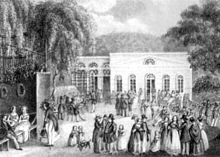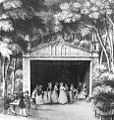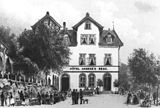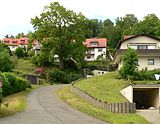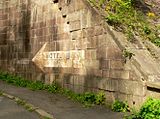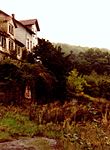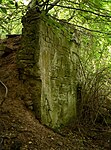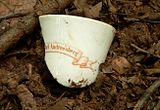Andree's mountain garden
Andree's Berggarten , later called Hotel Andree's Berg , was a hotel and restaurant in Hann. Münden in southern Lower Saxony , which emerged from a garden restaurant built around 1826 . The property founded by Ludwig Andree , a doctor from Münden , and named after him, was located above the town on a steep slope of the Questenberg . The open-air pub was a popular destination because of its delightful view and music concerts. After landslides in the early 1980s, the building complex was demolished in 1986 due to the risk of collapse .
history

From a publication in the Mündenschen Intellektivenblatt in 1826, it can be seen that the local town surgeon and surgeon Ludwig Andree was entertaining guests on his garden property on Questenberg at that time. According to his remarks, he was happy to allow strangers and locals to enter his mountain garden, but forbidden to enter through the hedge when the door was locked. The garden was about 22,000 m² in size, on which he bred leeches for medicinal leech treatment in a pond , which he sent across Europe. The garden lay on the steep slope of the Questenberg above the city and the suburb of Blume . From there there was a delightful view of the valley crossed by the rivers Werra , Fulda and Weser . Andree's Berggarten was the oldest establishment of its kind in town. Later the Bergschlösschen on the slope of the Kattenbühl and in the 1880s on the Rabanenkopf the excursion restaurant on the Tillyschanze were added.
In 1829 Ludwig Andree received a license from Landdrostei Hildesheim . The mountain garden developed into an open-air restaurant that was permanently open in the summer months. In the course of time, other entertainment options were offered, such as music concerts and fireworks as well as illuminations . This made the restaurant a popular excursion destination, to which visitors from Kassel, among others, came by ship. In 1849 the founder Ludwig Andree died. In 1853 the Mündener citizen Friedrich Bode bought the location. He and later his son expanded the garden restaurant into a hotel with a restaurant. From 1869 summer guests were taken into pension . Regular hotel operations began at the end of the 1880s. Before that, Andree's Berggarten had become a thriving venue for music concerts. At a major music festival in 1856, five military music corps performed. In 1889, the Göttingen music director Rudolf Bullerjahn gave eight summer concerts with his band, for which a music pavilion was built. During the First World War the hotel served as a reserve hospital .
building
In 1859 the hotel existed as a two-story building, and in 1882 a veranda was added as a larger extension. Around 1882, behind the main building, a smaller and a larger auxiliary building with two and three floors respectively, some with a stable for animals, were built. Around 1905 a larger abortion house was built. In the course of time, a larger building complex with a viewing terrace was built, to which a larger hall was last added in 1912 . In the 1930s a new music shell was built in the garden. During this time, the hotel advertised its preferred south-facing location on the high forest, central heating, a park-like garden and running water. After the Second World War, a terrace in the style of the time was constructed in the 1950s as the last construction project.
Decline
The hotel complex was located in the area of the Andreesberg , a steep slope on the south side of the Questenberg with meter-thick floating earth . In 1928 the hotel was given an access road, which resulted in steep embankments. In the mid-1930s, the street and the hotel terrace subsided by up to 50 cm per year. After heavy rainfall in 1939, cracks in the ground were found in the area, suggesting that the slope was sliding. Until 1940, the main wing of the hotel building was separated from the side wing by 25 cm. Cracks had formed on the walls and ceilings which, according to later investigations, were plastered on the surface. In 1981, after above-average rainfall, there was renewed ground movement on the Andreesberg. In 1982 all parts of the hotel's building had subsidence, creating gaps of up to 30 cm in the floors, ceilings and roof. Due to the danger of collapse , the main part of the hotel, which had been in disrepair for years, was demolished in 1986, followed by the rest of the building with ancillary buildings and a bed and service wing in 1990. Today (2016) the former hotel grounds are completely overgrown by bushes and trees. Individual remains of the walls of the buildings and terraces have been preserved on the edges of the terrain.
Old arrow pointing to the Hotel Andree's Berg on an underpass of the Dransfelder ramp
reception
The hotel serves as the central location in the 1993 novel Wolpertinger or Das Blau by Alban Nikolai Herbst . There it is referred to as Hotel Wolpertinger , in one narrative level also as Hotel Andree's Berg . The novel takes place in 1981, 1985 and 1989. The 1000-page work is considered to be the only great novel with Hannoversch Münden as the venue. In 1995, Herbst was awarded the Grimmelshausen Prize for the novel .
literature
- Karl Brethauer : "The Andree". 150 years significant for Münden in: Münden. Collected Essays. Second episode. Publisher Hans Fiedler, Hann. Münden, 1984, pp. 103-106
- Bodo Damm: Landslides in the low mountain range - Replaced "natural hazard"? In: Location - Journal for Applied Geography 4/2000, ( ku-eichstaett.de [PDF] and researchgate.net )
- Johann Dietrich von Pezold: The “Andreesberg” - garden bar, restaurant and hotel. In: History on the Three Rivers. A glimpse into the past of the city of Hann. Münden on the Werra, Fulda and Weser. Hann. Münden, 2008, pp. 66-69.
Web links
- Postcard with the hotel and view over Münden around 1900
- Postcard view of the hotel on a postcard from 1920
- Aerial photo of the hotel complex that was still in existence at the time of the recording
- Photos of the ruins of the hotel in the 1980s as the setting for the novel Wolpertinger or Das Blau
Individual evidence
- ↑ Abriß am Andreesberg in: Mündener Allgemeine from March 12, 1986
Coordinates: 51 ° 25 ′ 23 ″ N , 9 ° 39 ′ 16 ″ E
